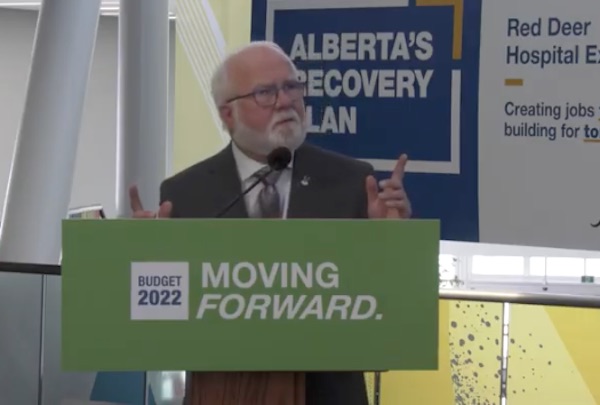Alberta
FINALLY! Province announces new Red Deer Hospital expansion and it’s much bigger than previous plan

Red Deer hospital $1.8B expansion builds for the future
Alberta’s government will invest $1.8 billion to redevelop and expand the Red Deer Regional Hospital Centre as part of the province’s strategy to increase health care capacity, providing central Albertans with better hospital care for years to come.
The $1.8 billion hospital expansion is the largest in Alberta’s history and the largest taxpayer investment in the history of central Alberta. It will begin with a $193 million investment over the next three years and will include 200 new in-patient beds, increasing hospital capacity from 370 beds to 570 beds or by 54 per cent.
The expansion also provides for three new operating rooms, increasing surgical capacity to 14 operating rooms.
A new cardiac catheterization lab will also be part of the hospital’s expansion.
“For too long, central Albertans have been waiting for these critical upgrades and expansion of the Red Deer Regional Hospital. That’s why we’ve made expanding the Red Deer Regional Hospital a priority, and we’re putting our money where our mouth is. Alberta’s Recovery Plan has already seen healthcare infrastructure built from Grande Prairie to Calgary, and now, it’s making sure world-class health care is there for Red Deer and central Alberta for years to come with the largest investment in the history of central Alberta.”
“This important investment will ensure the Red Deer Regional Hospital Centre continues to provide exceptional quality hospital care for the residents in the Red Deer region for decades to come. This investment is a key component of the Alberta government’s commitment to building health-care capacity throughout the province.”
The project’s next steps include functional programming and design. Completion of the expansion is slated for 2030-2031.
“Red Deer and central Alberta’s growing populations mean that our ability to effectively provide health care with the current hospital is limited, resulting in all too frequent disruptions to patient care. This needed redevelopment will increase capacity and expand services to meet central Albertans’ needs into the future. It’s another example of our government’s commitment to build health system capacity throughout Alberta.”
“I know how important this project is to the residents of central Alberta. This important expansion of the Red Deer hospital will create jobs and improve residents’ access to health-care services in the years to come.”
“The expansion of the Red Deer Regional Hospital Centre is extremely significant for our city and long overdue. This historical investment means that central Albertans will benefit from increased surgical and in-patient capacity, benefiting our community in ways that were previously not possible. In addition, I am so pleased that local patients will finally have a cardiac catheterization lab as part of this amazing expansion, which will literally save lives. As the third-largest city in the province, this expansion will go a long way in providing the medical care and attention we have long needed and strongly advocated for.”
“This is welcome news for our staff and physicians at Red Deer Regional Hospital Centre, as well as to all those we care for within its walls. Being able to expand our in-patient capacity, as well as critical programs like surgical services with new operating rooms, is paramount to continuing to serve the health-care needs of central Albertans as so many rely on Red Deer Regional. On behalf of Alberta Health Services, we are grateful for the support of government partners in moving this project forward, and for the ongoing efforts of our teams who eagerly await this expansion.”
“This is a monumental day for our city and for the central Alberta region. It is with extreme gratitude that we recognize the provincial government for this significant investment in the care of central Albertans.”
“Located along one of the busiest transportation corridors in the province, Red Deer County serves close to 20,000 residents within central Alberta. The county welcomes this news and is appreciative of the Government of Alberta’s capital investment to our region for the improvement of health care for our residents.”
Quick facts
- The Red Deer Regional Hospital Centre is the busiest hospital outside of Edmonton and Calgary. It has the fourth-highest volume of any Alberta Health Services’ facility.
- Approximately 50 per cent of patients seen at the hospital are referred from communities outside of Red Deer.
- The hospital offers a full spectrum of acute care, including advanced surgery, internal medicine and diagnostics, as well as obstetrics, pediatrics, oncology, critical care and emergency care.
- $100 million was allocated to the project in Budget 2020.
Alberta
Alberta judge sides with LGBT activists, allows ‘gender transitions’ for kids to continue

From LifeSiteNews
‘I think the court was in error,’ Alberta Premier Danielle Smith has said. ‘There will be irreparable harm to children who get sterilized.’
LGBT activists have won an injunction that prevents the Alberta government from restricting “gender transitions” for children.
On June 27, Alberta King’s Court Justice Allison Kuntz granted a temporary injunction against legislation that prohibited minors under the age of 16 from undergoing irreversible sex-change surgeries or taking puberty blockers.
“The evidence shows that singling out health care for gender diverse youth and making it subject to government control will cause irreparable harm to gender diverse youth by reinforcing the discrimination and prejudice that they are already subjected to,” Kuntz claimed in her judgment.
Kuntz further said that the legislation poses serious Charter issues which need to be worked through in court before the legislation could be enforced. Court dates for the arguments have yet to be set.
READ: Support for traditional family values surges in Alberta
Alberta’s new legislation, which was passed in December, amends the Health Act to “prohibit regulated health professionals from performing sex reassignment surgeries on minors.”
The legislation would also ban the “use of puberty blockers and hormone therapies for the treatment of gender dysphoria or gender incongruence” to kids 15 years of age and under “except for those who have already commenced treatment and would allow for minors aged 16 and 17 to choose to commence puberty blockers and hormone therapies for gender reassignment and affirmation purposes with parental, physician and psychologist approval.”
Just days after the legislation was passed, an LGBT activist group called Egale Canada, along with many other LGBT organizations, filed an injunction to block the bill.
In her ruling, Kuntz argued that Alberta’s legislation “will signal that there is something wrong with or suspect about having a gender identity that is different than the sex you were assigned at birth.”
She further claimed that preventing minors from making life-altering decisions could inflict emotional damage.
However, the province of Alberta argued that these damages are speculative and the process of gender-transitioning children is not supported by scientific evidence.
“I think the court was in error,” Alberta Premier Danielle Smith said on her Saturday radio show. “That’s part of the reason why we’re taking it to court. The court had said there will be irreparable harm if the law goes ahead. I feel the reverse. I feel there will be irreparable harm to children who get sterilized at the age of 10 years old – and so we want those kids to have their day in court.”
READ: Canadian doctors claim ‘Charter right’ to mutilate gender-confused children in Alberta
Overwhelming evidence shows that persons who undergo so-called “gender transitioning” procedures are more likely to commit suicide than those who are not given such irreversible surgeries. In addition to catering to a false reality that one’s sex can be changed, trans surgeries and drugs have been linked to permanent physical and psychological damage, including cardiovascular diseases, loss of bone density, cancer, strokes and blood clots, and infertility.
Meanwhile, a recent study on the side effects of “sex change” surgeries discovered that 81 percent of those who have undergone them in the past five years reported experiencing pain simply from normal movements in the weeks and months that followed, among many other negative side effects.
Alberta
Alberta Independence Seekers Take First Step: Citizen Initiative Application Approved, Notice of Initiative Petition Issued

Alberta’s Chief Electoral Officer, Gordon McClure, has issued a Notice of Initiative Petition.
This confirms a Citizen Initiative application has been received and the Chief Electoral Officer has determined the requirements of section 2(3) of the Citizen Initiative Act have been met.
Approved Initiative Petition Information
The approved citizen initiative application is for a policy proposal with the following proposed question:
Do you agree that Alberta should remain in Canada?
The Notice of Initiative Petition, application, and statement provided by the proponent are available on Elections Alberta’s website on the Current Initiatives Petition page.
As the application was received and approved prior to coming into force of Bill 54: Election Statutes Amendment Act, the Citizen Initiative process will follow requirements set out in the Citizen Initiative Act as of June 30, 2025.
Next Steps
- The proponent must appoint a chief financial officer within 30 days (by July 30, 2025).
- Once the 30-day publication period is complete and a chief financial officer has been appointed, Elections Alberta will:
- issue the citizen initiative petition,
- publish a notice on the Current Initiatives Petition page of our website indicating the petition has been issued, specifying the signing period dates, and the number of signatures required for a successful petition, and
- issue the citizen initiative petition signature sheets and witness affidavits. Signatures collected on other forms will not be accepted.
More information on the process, the status of the citizen initiative petition, financing rules, third party advertising rules, and frequently asked questions may be found on the Elections Alberta website.
Elections Alberta is an independent, non-partisan office of the Legislative Assembly of Alberta responsible for administering provincial elections, by-elections, and referendums.
-

 Brownstone Institute2 days ago
Brownstone Institute2 days agoFDA Exposed: Hundreds of Drugs Approved without Proof They Work
-

 Energy1 day ago
Energy1 day agoChina undermining American energy independence, report says
-

 Business1 day ago
Business1 day agoTrump on Canada tariff deadline: ‘We can do whatever we want’
-

 Automotive1 day ago
Automotive1 day agoElectric vehicle sales are falling hard in BC, and it is time to recognize reality.
-

 Business1 day ago
Business1 day agoEurope backs off greenwashing rules — Canada should take note
-

 Automotive1 day ago
Automotive1 day agoPower Struggle: Electric vehicles and reality
-

 Business8 hours ago
Business8 hours agoCanada Caves: Carney ditches digital services tax after criticism from Trump
-

 Bruce Dowbiggin7 hours ago
Bruce Dowbiggin7 hours agoThe Game That Let Canadians Forgive The Liberals — Again






